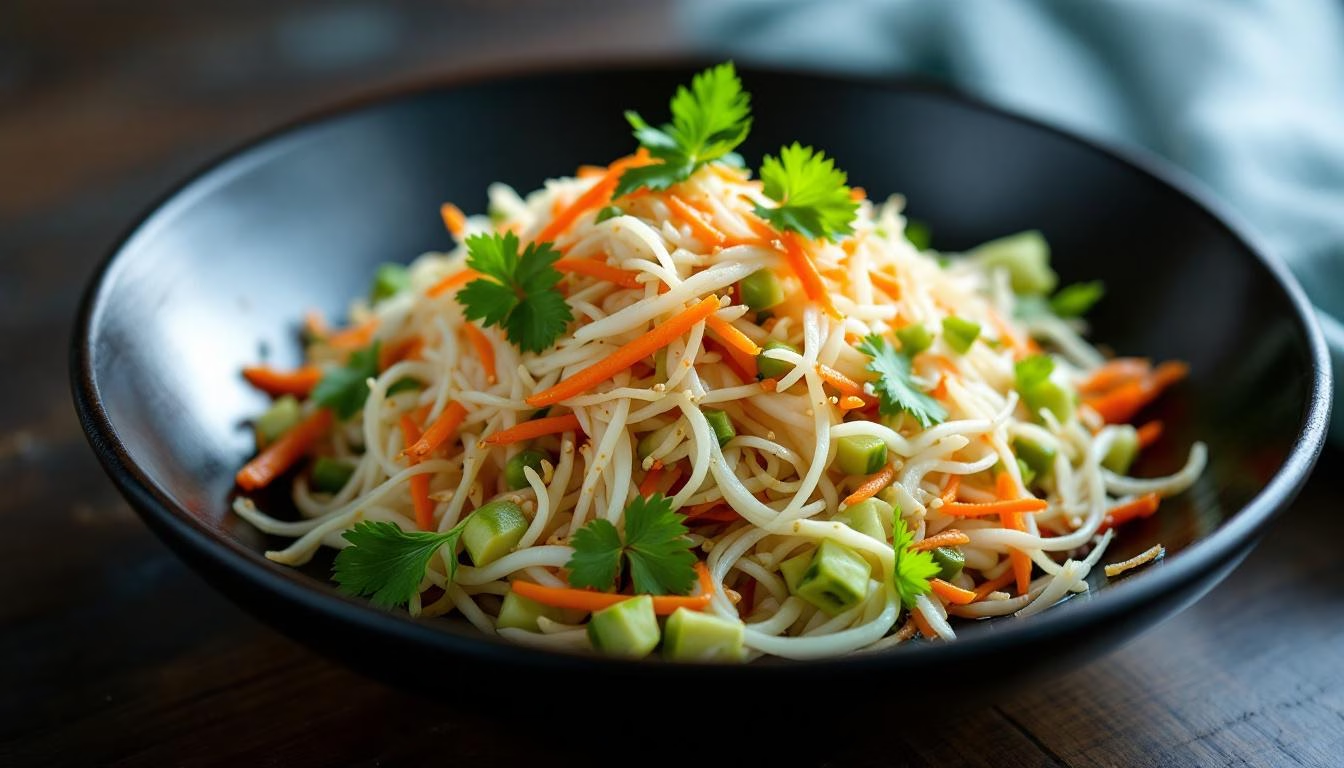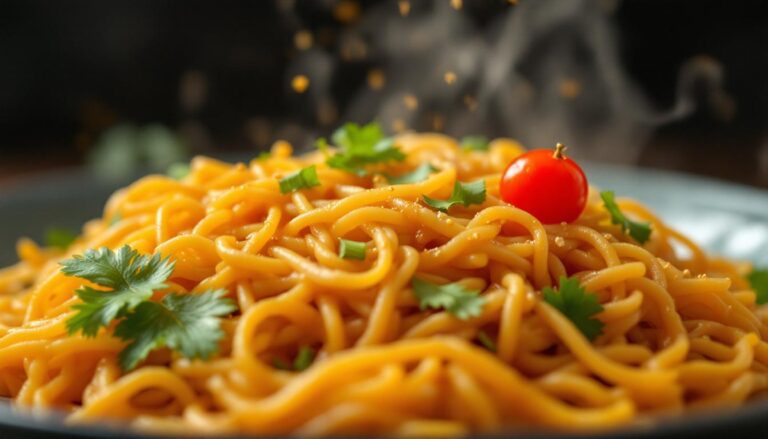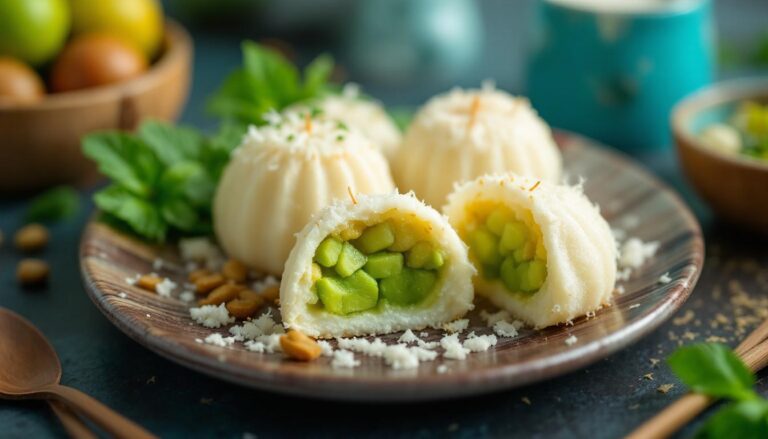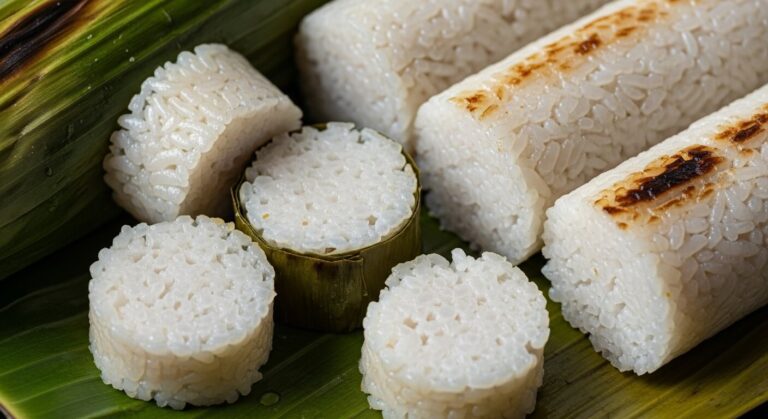Urap Sayur Recipe: Indonesian Coconut Vegetable Salad
Indonesian Urap Sayur Recipe: The Ultimate Coconut Vegetable Salad – I used to think I was pretty adventurous with salads.
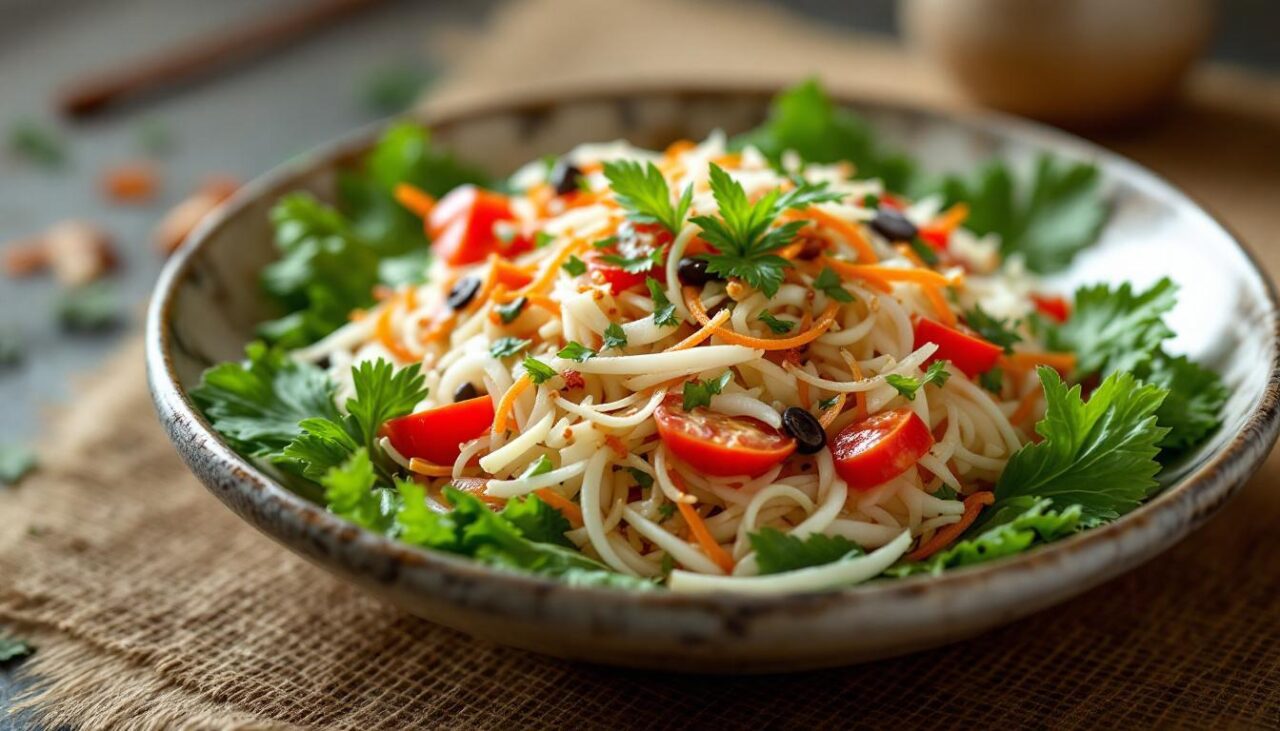
Urap Sayur Salad (Indonesian Coconut Vegetables)
Ingredients
- ¾ cup desiccated coconut
- 6 makrut lime leaves (aka kaffir lime leaves, thinly sliced)
- 2 tablespoons tamarind concentrate
- ¼ teaspoon salt
- 2 bird’s eye chilies (stems removed)
- 1 Fresno chili (stem removed)
- 1 teaspoon grated galangal
- 1 teaspoon lemongrass powder
- 2 cloves garlic (peeled)
- 2 shallots (peeled and quartered)
- 1 tablespoon lime juice
- 1 teaspoon salt
- 200 grams green beans – cut into 1-inch (2.5 cm. pieces)
- 300 grams cabbage (chopped)
- 150 grams mung bean sprouts (about 2 ½ cups)
- 2 tablespoons olive oil (or canola oil, or vegetable oil)
- 300 grams bunched spinach (two bunches, washed well)
- 2 scallions (thinly sliced)
- Bird’s eye chili (thinly sliced to taste)
Instructions
- Toast the desiccated coconut in a medium pan over medium heat until lightly golden and fragrant.
- Add the sliced makrut lime leaves, tamarind concentrate, and salt; sauté until mostly dry, then set aside.
- Blend bird’s eye chilies, Fresno chili, grated galangal, lemongrass powder, garlic, shallots, lime juice, and salt to a smooth paste.
- Bring a medium pot of water to a boil over high heat. Add the green beans and cook for 60 seconds. Stir in the cabbage and beansprouts and cook another 45 seconds to blanch.
- Drain the vegetables in a colander, then immediately transfer them to a bowl of ice water to preserve their color and texture.
- Heat oil in a pan over medium heat. After 90 seconds, when the oil is hot, stir in the pureed sambal and sauté for 4 minutes until the shallots soften and become very fragrant.
- Drain the blanched vegetables in a colander and dry them as thoroughly as possible.
- Add the spinach to the pan with the sambal and stir to coat it with the seasonings.
- As soon as the spinach is coated with sambal, add the drained blanched vegetables to the pan. Stir-fry for about 1 minute until all the vegetables are warm and thoroughly coated in the sambal.
- Transfer everything from the pan to a serving dish and generously sprinkle with the coconut topping. Garnish, if desired, with thinly sliced scallions and bird’s eye chilies.
Nutrition
You know, throwing some quinoa on greens, adding a few cranberries, maybe getting wild with some goat cheese.
Then I met my neighbor Sari, who moved here from Jakarta three years ago, and she completely upended my understanding of what a salad could be.
It was a sweltering August afternoon when she knocked on my door with a covered dish, apologizing for the “simple lunch” she’d brought over after I’d helped her move some furniture.
Simple?
This Urap Sayur Salad (Indonesian Coconut Vegetables) recipe was anything but simple – it was a revelation wrapped in toasted coconut and perfumed with makrut lime leaves.
The first bite was like a symphony in my mouth.
Crisp-tender vegetables that somehow maintained their individual personalities while harmonizing perfectly, all bound together with a fragrant sambal that had just enough heat to make my eyes water (in the best way).
The toasted coconut wasn’t just a garnish – it was integral, adding this nutty richness that made every bite feel substantial and satisfying.
I may have embarrassed myself by asking for the recipe before I’d even finished my first serving, but Sari just laughed and promised to teach me the next weekend.
That weekend turned into a monthly cooking session that’s become one of my favorite traditions.
What struck me most about learning this Urap Sayur Salad (Indonesian Coconut Vegetables) recipe wasn’t just how delicious it was, but how it completely changed my relationship with vegetables.
This isn’t a salad where vegetables play supporting roles to protein or cheese – they’re the stars, each one carefully prepared to showcase its best qualities while contributing to a greater whole.
The Beautiful Tradition Behind Urap Sayur: Indonesian Coconut Vegetable Salad
Urap Sayur holds a special place in Indonesian cuisine, particularly in Javanese cooking where it originated.
The word “urap” refers to the technique of mixing vegetables with spiced coconut, while “sayur” simply means vegetables.
This isn’t just any salad – it’s a dish that represents the Indonesian philosophy of balance, bringing together different textures, temperatures, and flavors in perfect harmony.
Traditionally served as part of a larger meal called “nasi gudeg” or alongside rice and other dishes, Urap Sayur demonstrates the Indonesian mastery of vegetable cookery.
The technique of blanching vegetables just until crisp-tender, then shocking them in ice water, preserves both their vibrant colors and optimal textures.
Meanwhile, the sambal – that fragrant paste of chilies, aromatics, and spices – provides the flavor foundation that transforms simple vegetables into something extraordinary.
What makes this Urap Sayur Salad (Indonesian Coconut Vegetables) recipe particularly special is the toasted coconut topping, scented with makrut lime leaves and tamarind.
This isn’t just a garnish – it’s a flavor component that adds richness, texture, and an almost floral fragrance that elevates the entire dish.
The combination creates layers of flavor that unfold with each bite, from the initial hit of sambal heat to the cooling crunch of vegetables and the lingering sweetness of coconut.
Mastering the Urap Sayur Technique
Creating an authentic Urap Sayur Salad (Indonesian Coconut Vegetables) recipe requires understanding a few key techniques that might seem unfamiliar at first, but become second nature once you’ve made it a few times.
The magic happens in the careful balance of timing, temperature, and texture.
Building the Aromatic Coconut Topping
The foundation of great Urap Sayur starts with the coconut topping, which provides both flavor and textural contrast.
This step requires patience and attention, but the results are absolutely worth it.
Toast the Coconut: Start by heating a medium pan over medium heat – no oil needed.
Add ¾ cup of desiccated coconut and toast it, stirring frequently, until it turns a light golden color and becomes wonderfully fragrant.
This usually takes about 3-4 minutes, but don’t walk away from the stove!
Coconut can go from perfectly toasted to burnt in a matter of seconds.
You’ll know it’s ready when it smells nutty and looks evenly golden.
Add the Aromatics: Once your coconut is perfectly toasted, add 6 thinly sliced makrut lime leaves (if you can’t find fresh ones, frozen work fine – just don’t use dried), 2 tablespoons of tamarind concentrate, and ¼ teaspoon of salt.
Sauté this mixture for another 2-3 minutes until it’s mostly dry and incredibly fragrant.
The tamarind will add a subtle sourness that balances the richness of the coconut, while the lime leaves provide that distinctive citrusy aroma that’s essential to authentic Indonesian flavors.
Set this aside – it’s your flavor bomb that’ll crown the finished dish.
Creating the Perfect Sambal Base
The sambal is where this Urap Sayur Salad (Indonesian Coconut Vegetables) recipe really shows its personality.
This isn’t just about heat – it’s about building complex, layered flavors that will coat and complement your vegetables.
Blend the Aromatics: In a food processor or high-powered blender, combine 2 bird’s eye chilies (stems removed), 1 Fresno chili (stem removed), 1 teaspoon grated galangal, 1 teaspoon lemongrass powder, 2 peeled garlic cloves, 2 peeled and quartered shallots, 1 tablespoon lime juice, and 1 teaspoon salt.
Blend until you have a smooth paste – this might take a few minutes and you may need to stop and scrape down the sides a couple times.
Don’t worry if you can’t find galangal or lemongrass powder at your regular grocery store – Asian markets usually carry them, and online ordering is always an option.
The galangal provides a sharp, almost pine-like flavor that’s different from ginger, while lemongrass powder adds that distinctive citrusy note.
If you absolutely can’t find galangal, you can substitute fresh ginger, but use about half the amount as it’s more potent.
Perfecting the Vegetable Preparation
The vegetables in this Urap Sayur Salad (Indonesian Coconut Vegetables) recipe need to be cooked just enough to be tender but still maintain their crunch and vibrant colors.
This technique, called blanching, is crucial to the dish’s success.
Blanch with Precision: Bring a medium pot of water to a rolling boil over high heat.
Add 200 grams of green beans (cut into 1-inch pieces) first and cook for exactly 60 seconds.
Then add 300 grams of chopped cabbage and 150 grams of mung bean sprouts, cooking for another 45 seconds.
The timing here is crucial – you want the vegetables to be crisp-tender, not mushy.
The Ice Bath Technique: Immediately drain the vegetables and plunge them into a bowl of ice water.
This stops the cooking process instantly and preserves both the vibrant green color and the perfect texture.
Let them sit in the ice bath for about 2 minutes, then drain thoroughly.
I can’t stress enough how important it is to get them as dry as possible – excess water will dilute your sambal and make the finished dish watery.
Bringing It All Together
The final assembly is where this Urap Sayur Salad (Indonesian Coconut Vegetables) recipe comes alive, transforming individual components into a cohesive, flavorful dish.
Cook the Sambal: Heat 2 tablespoons of oil in a large pan over medium heat.
After about 90 seconds, when the oil is hot but not smoking, add your sambal paste.
Sauté for about 4 minutes, stirring frequently, until the shallots have softened and the mixture is very fragrant.
You’ll know it’s ready when the raw garlic smell disappears and is replaced by a complex, aromatic fragrance.
Add the Spinach: Add 300 grams of clean spinach (about two bunches) to the pan with the sambal.
Stir quickly to coat the spinach with the seasonings – it will wilt almost immediately, so work fast.
Final Assembly: As soon as the spinach is coated with sambal, add your drained blanched vegetables.
Stir-fry for about 1 minute until everything is warmed through and thoroughly coated in the fragrant sambal.
Transfer to a serving dish and generously sprinkle with your toasted coconut mixture.
Garnish with thinly sliced scallions and additional bird’s eye chilies if you want extra heat.
Pro Tips for Urap Sayur Success
After making this Urap Sayur Salad (Indonesian Coconut Vegetables) recipe dozens of times, I’ve learned a few tricks that make the difference between good and absolutely spectacular results.
Ingredient Substitutions and Sourcing
Finding Authentic Ingredients: Makrut lime leaves can usually be found in the freezer section of Asian grocery stores if fresh aren’t available.
Don’t substitute regular lime zest – the flavor is completely different.
For tamarind concentrate, look for the thick, dark paste rather than the watery tamarind juice.
If you can only find tamarind paste with seeds, strain it before using.
Spice Level Adjustments: Bird’s eye chilies pack serious heat – if you’re sensitive to spice, start with just one and taste before adding more.
You can always add heat, but you can’t take it away!
Conversely, if you love heat, feel free to add more bird’s eye chilies or include some of the seeds.
Vegetable Variations: While the traditional combination is fantastic, this recipe is quite forgiving.
You can substitute or add other quick-cooking vegetables like snap peas, broccoli florets, or even thinly sliced bell peppers.
Just adjust the blanching time accordingly – harder vegetables need a bit longer, while delicate ones need less time.
Timing and Make-Ahead Tips
Component Preparation: You can make the coconut topping up to three days ahead and store it in an airtight container at room temperature.
The sambal paste can be prepared a day ahead and refrigerated, though you’ll want to bring it to room temperature before cooking.
Best Serving Practices: This Urap Sayur Salad (Indonesian Coconut Vegetables) recipe is best served immediately after assembly while the vegetables are still slightly warm and the coconut topping is at its most fragrant.
However, if you need to hold it for a short time, keep the components separate and assemble just before serving.
Troubleshooting Common Issues
Watery Results: If your finished dish seems watery, you probably didn’t dry the blanched vegetables thoroughly enough.
Next time, pat them completely dry with paper towels after draining from the ice bath.
Burnt Coconut: Coconut can go from perfectly toasted to burnt very quickly.
If this happens, start over – there’s no saving burnt coconut, and it will make the entire dish bitter.
Bland Flavor: If the dish tastes flat, you probably need more salt or lime juice.
Taste and adjust the sambal before adding the vegetables, and don’t be afraid to add a squeeze of fresh lime juice at the end.
Creative Variations on the Classic
Once you’ve mastered the basic Urap Sayur Salad (Indonesian Coconut Vegetables) recipe, there are several delicious variations you can explore to keep things interesting.
Protein Additions
While traditional Urap Sayur is vegetarian, you can easily turn it into a more substantial meal by adding protein.
Sliced hard-boiled eggs are a classic addition that doesn’t interfere with the traditional flavors.
For something more substantial, try adding shredded rotisserie chicken or cooked shrimp during the final stir-fry stage.
Seasonal Vegetable Swaps
This recipe adapts beautifully to whatever vegetables are in season.
In spring, try adding asparagus or sugar snap peas.
Summer calls for zucchini or yellow squash, while fall vegetables like Brussels sprouts or cauliflower work wonderfully.
Just remember to adjust blanching times based on the density of your chosen vegetables.
Coconut Variations
While desiccated coconut is traditional and convenient, you can experiment with fresh grated coconut if you can find it.
The texture will be slightly different – more tender and less crispy – but the flavor is incredible.
You can also try adding a tablespoon of coconut oil to the sambal for extra richness.
Heat Level Modifications
For a milder version suitable for kids or heat-sensitive palates, reduce the chilies and add a teaspoon of sweet paprika for color and mild pepper flavor.
For heat lovers, try adding a finely minced habanero or scotch bonnet pepper to the sambal blend.
What to Expect: Your Urap Sayur Journey
Let me be honest about what you’re getting into with this Urap Sayur Salad (Indonesian Coconut Vegetables) recipe.
This isn’t a throw-together weeknight dish – it requires some planning, a trip to an Asian grocery store for authentic ingredients, and about 45 minutes of active cooking time.
But here’s the thing: every single minute is worth it.
Your first attempt might not look exactly like the picture-perfect versions you see online, and that’s completely okay.
Mine certainly didn’t!
The coconut might get a little darker than intended, or you might go heavy-handed with the chilies (been there, done that, cried through dinner).
But even an imperfect Urap Sayur is still absolutely delicious, and you’ll learn something with each attempt.
What you can expect is a dish that will surprise anyone who thinks salad means boring diet food.
The combination of textures – crisp vegetables, tender spinach, crunchy coconut – creates interest in every bite.
The flavors are complex but balanced, with heat that builds gradually rather than overwhelming immediately.
And the aroma? Absolutely intoxicating.
This Urap Sayur Salad (Indonesian Coconut Vegetables) recipe has become one of my go-to dishes for dinner parties because it’s impressive enough to wow guests but approachable enough that I’m not stressed about making it.
Plus, it’s naturally gluten-free and can easily be made vegan, which makes it perfect for feeding a crowd with diverse dietary needs.
Just don’t be surprised when everyone asks for the recipe – I’ve probably shared it with half my neighborhood by now!
Urap Sayur Salad (Indonesian Coconut Vegetables)
Prep Time: 4 minutes | Cook Time: 16 minutes | Total Time: 20 minutes | Serves: 6
For the Coconut Topping:
- ¾ cup desiccated coconut
- 6 makrut lime leaves, thinly sliced
- 2 tablespoons tamarind concentrate
- ¼ teaspoon salt
For the Sambal:
- 2 bird’s eye chilies, stems removed
- 1 Fresno chili, stem removed
- 1 teaspoon grated galangal
- 1 teaspoon lemongrass powder
- 2 cloves garlic, peeled
- 2 shallots, peeled and quartered
- 1 tablespoon lime juice
- 1 teaspoon salt
For the Vegetables:
- 200 grams green beans, cut into 1-inch pieces
- 300 grams cabbage, chopped
- 150 grams mung bean sprouts
- 2 tablespoons olive oil
- 300 grams bunched spinach, washed well
- 2 scallions, thinly sliced
- Bird’s eye chili, thinly sliced (optional)
Instructions to Cook Urap Sayur Recipe
- Toast coconut: Toast desiccated coconut in a medium pan over medium heat until lightly golden and fragrant.
- Sauté with aromatics: Add sliced makrut lime leaves, tamarind concentrate, and salt; sauté until mostly dry, then set aside.
- Blend sambal: Blend bird’s eye chilies, Fresno chili, galangal, lemongrass powder, garlic, shallots, lime juice, and salt to a smooth paste.
- Blanch vegetables: Bring a pot of water to boil. Add green beans and cook 60 seconds. Add cabbage and bean sprouts, cook another 45 seconds.
- Shock in ice water: Drain vegetables, immediately transfer to ice water to preserve color and texture.
- Cook sambal: Heat oil in pan over medium heat. Add sambal paste and sauté 4 minutes until fragrant.
- Drain vegetables: Drain blanched vegetables thoroughly and pat dry.
- Add spinach: Add spinach to pan with sambal, stir to coat.
- Final stir-fry: Add drained vegetables to pan, stir-fry 1 minute until warmed and coated.
- Serve: Transfer to serving dish, sprinkle generously with coconut topping, garnish with scallions and chilies.
Nutrition per serving: 172 calories, 16g carbs, 5g protein, 12g fat, 5g fiber


